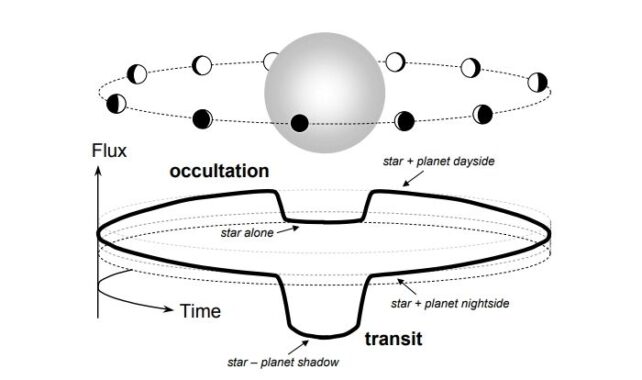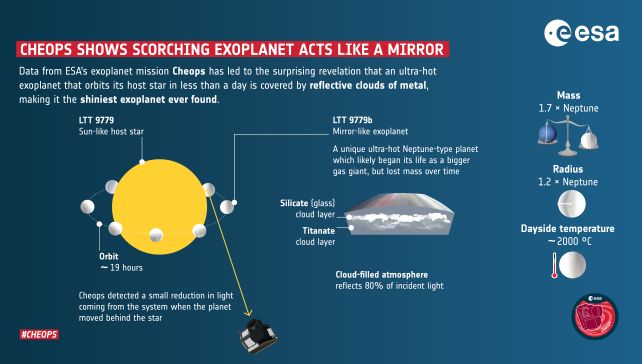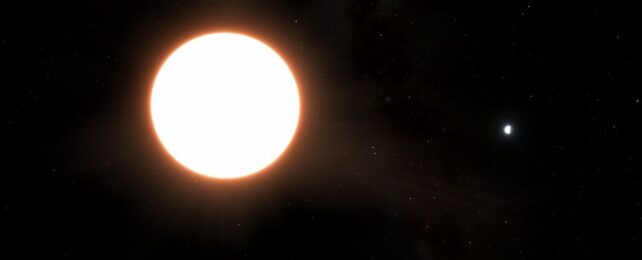The shiniest exoplanet ever found in our galaxy has clouds made of glass and titanium.
It's called LTT-9779b, located some 263 light-years away, and it's so shiny that it's almost a mirror, reflecting a jaw-dropping 80 percent of the light from its host star. That's shinier than Venus, known for its high brightness which reflects around three quarters of the light that falls on it.
And that's not all. The Neptune-sized world is scorchingly hot, with temperatures that reach 2,100 Kelvin (1,827 degrees Celsius, or 3,320 Fahrenheit). That's the hottest temperature ever seen in an exoplanet of this type.
"Imagine a burning world, close to its star, with heavy clouds of metals floating aloft, raining down titanium droplets," says astronomer James Jenkins of Diego Portales University in Chile.
This remarkable discovery was made using the European Space Agency's CHaracterising ExOPlanet Satellite (Cheops). The exoplanet and its orbit were initially found and characterized using other instruments, but Cheops took a longer, closer look to obtain a highly detailed set of data known as a phase curve.

As an exoplanet orbits a star, the amount of light emitted by the system changes. When the planet is in front of the star, the star's light dims; but the light also dims when the planet is behind the star. That's because when it's to either side, the light it emits and reflects adds to the overall light emitted by the system.
Astronomers can use this information to extract how much light the exoplanet is giving off, subtracting the light emitted by heat. This is how they obtained the reflectiveness of LTT-9779b, a measurement known as albedo. Earth, for context, has an albedo of 0.3; it reflects 30 percent of the Sun's light. Venus has an albedo of 0.75.
However, LTT-9779b's atmosphere is strange. At temperatures that scorching, any atmosphere is expected to boil off, basically – even ones with clouds of glass and metal. Its presence, the researchers found, suggests that there's an oversaturation of these materials.

"To steam up a bathroom you can either cool the air until water vapor condenses, or you can keep the hot water running until clouds form because the air is so saturated with vapor that it simply can't hold any more," says astronomer Vivien Parmentier of the Observatory of Côte d'Azur in France. "Similarly, LTT-9779b can form metallic clouds despite being so hot because the atmosphere is oversaturated with silicate and metal vapors."
Even so, the astronomers say the exoplanet, according to models, "shouldn't exist". It's 4.7 times the radius and 29 times the mass of Earth, and it whips round its Sun-like star on a blistering 19-hour orbit. This places it in the 'hot Neptune desert'. We've found very few worlds like this, because they don't survive the X-ray and ultraviolet irradiation from their stars.
Studies have shown that its higher gravity could be helping LTT-9779b retain its atmosphere against intense stellar irradiation, but the new findings suggest a second retention mechanism.
"We believe these metal clouds help the planet to survive in the hot Neptune desert," explains astrophysicist Sergio Hoyer of the Marseille Astrophysics Laboratory in France.
"The clouds reflect light and stop the planet from getting too hot and evaporating. Meanwhile, being highly metallic makes the planet and its atmosphere heavy and harder to blow away."
The research has been published in Astronomy & Astrophysics.
